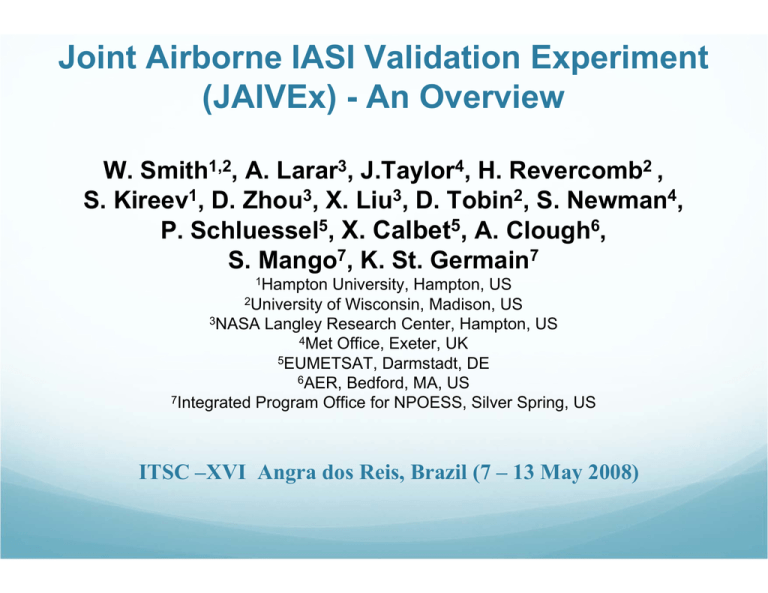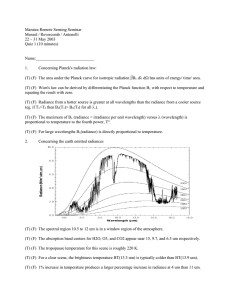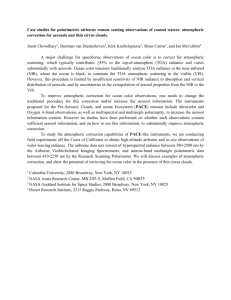Joint Airborne IASI Validation Experiment (JAIVEx) - An Overview X. Calbet ,
advertisement

Joint Airborne IASI Validation Experiment (JAIVEx) - An Overview W. Smith1,2, A. Larar3, J.Taylor4, H. Revercomb2 , S. Kireev1, D. Zhou3, X. Liu3, D. Tobin2, S. Newman4, P. Schluessel5, X. Calbet5, A. Clough6, S. Mango7, K. St. Germain7 1Hampton University, Hampton, US 2University of Wisconsin, Madison, US 3NASA Langley Research Center, Hampton, US 4Met Office, Exeter, UK 5EUMETSAT, Darmstadt, DE 6AER, Bedford, MA, US 7Integrated Program Office for NPOESS, Silver Spring, US ITSC –XVI Angra dos Reis, Brazil (7 – 13 May 2008) Objectives of Airborne Field Campaigns • Radiometric and spectral calibration of satellite sensors • Cross-validation of sensors in different orbits • Validation of forward radiative transfer models used for retrieval of geophysical variables • Provision of accurate in-situ and well calibrated ground-based, airborne and satellite radiance data sets for: - Cal/Val of satellite radiance sensors in orbit - Conducting studies to define limitations of current sensing techniques and to define more optimal sensing approaches - Simulating instrument measurements and validating processing algorithms intended for future satellite systems - Performing regional Observing System Experiments (OSEs) to define NWP impact of current and simulated future satellite systems Unique Contribution of the Airborne Component • Simultaneous independent, SI traceable radiance measurements for absolute radiometric and spectral cal/val of satellite sensors • Transfer standard for cross-validation of sensors in different orbits at more than a very limited number of polar latitudes • Provides simultaneous accurate in-situ and remotely sensed geophysical variables that characterize the entire footprint of the satellite sounder for validation of satellite products and forward radiative transfer models used for their derivation • Provides the high spatial resolution coupled with the high spectral resolution radiance measurements needed to determine the impact of satellite measurement characteristics on the accuracy of the derived products Joint Airborne IASI Validation Experiment (JAIVEx) WB-57 BAe-146-301 US-European collaboration focusing on the validation of radiance and geophysical products from MetOp-A (1st advanced sounder in the Joint Polar System) y Location/dates y Ellington Field (EFD), Houston, TX, 14 Apr – 4 May, 2007 y Aircraft y NASA WB-57 (NAST-I, NAST-M, S-HIS) y UK FAAM BAe146-301 (ARIES, MARSS, Deimos, SWS; dropsondes; in-situ cloud phys. & trace species; etc.) y Ground-sites y DOE ARM CART ground site: RAOBS (1.5 hr apart at overpass time), Raman Lidar, AERI, etc. y Satellites y MetOp-A (IASI, AMSU, MHS, AVHRR, HIRS, GOME, SBUV, ACAT) y A-train (Aqua AIRS, AMSU, HSB, MODIS; Aura TES; CloudSat; and Calipso) y Participants y US: NASA/LaRC, NASA/JSC, UW, MIT-LL, MIT, NOAA, others y Europe: UKMO, FAAM, U. of Manchester, EUMETSAT, U of Bologna, ECMWF, others y Sponsors y US: IPO, NASA, NOAA y European: FAAM, UKMO, UK-NERC, EUMETSAT Seven JAIVEx MetOp Cal/Val Flights CART-site CART-site MetOp & Aqua MetOp & Aqua MetOp- Night Night Gulf- Night CART-site MetOp Day CART site Day MetOp & Aqua MetOp & Aqua Gulf - Day MetOp & Aqua Gulf - Day Four CART-site (2 day & 2 night); Three Gulf of Mexico (2 day & 1 night); Five joint MetOp & Aqua (3 day & 2 night) Simultaneous Independent SI Traceable Radiance Measurements for Absolute Radiometric and Spectral Cal/Val of Satellite Sensors IASI, NAST-I, and SHIS Longwave JAIVEx (April 19, 2007) Discrepancies are due to contributions to the IASI measurements by the atmosphere above the NAST-I and SHIS aircraft altitude (~ 18 km) Wavenumber (cm-1) (IASI L1C and NAST-I spectra processed to match SHIS spectral resolution) Midwave Shortwave Multiple Airborne Sensors Provides an Internally Verified Assessment of Satellite Sensor Performance Thereby Enabling More Immediate Use of the Data Transfer Standard for Cross-Validation of Sensors in Different Orbits Wavenumber (cm-1) Wavenumber (cm-1) Midwave Radiance Spectra (deviation from latitudinal mean) Vs Latitude for two NAST-I Nadir Track Legs Under the MetOp IASI and Aqua AIRS Satellite Instruments at Their Individual Overpass Times Latitude Wavenumber (cm-1) Wavenumber (cm-1) Latitude Latitude Latitude JAIVEx (April 29, 2007) Airborne Radiance Spectra Enables Cross-Validation of Satellite Instruments in Different Orbits Simultaneous Accurate In-situ and Remotely Sensed Geophysical Variables for Validation of Satellite Products and Forward Radiative Transfer Models Used for Their Derivation JAIVEx (April 19/29, 2007) Aircraft Dropsondes & Science Quality Radiosondes Used to Validate Radiative Transfer Models and Satellite Retrieval Products Example Use of the JAIVEx Data Set For Atmospheric Retrieval and Associated Radiance Assimilation Problem Studies The Problem: Due to the strong non-linearity of atmospheric water radiance, with respect to the water vapor and temperature profile, and due to the strong water vapor radiance Jacobians for atmospheric temperature [i.e., (dR(ν)/dT(p) where water vapor is the primary emitter], the 1-d variational physical retrieval of atmospheric temperature profiles can be compromised by the direct use of water vapor radiances when the initial water vapor profile (or background state) deviates greatly from the true profile. This problem is particularly acute for the hyperspectral sounder where the measured radiance spectrum is dominated by water radiance contributions. Potential solution: (1) Solve for an initial temperature and moisture profile using linear regression, which generally yields good temperature profile solution due to the near linear relation between radiance and atmospheric temperature for invariant atmospheric constituents. (2) Obtain a non-linear 1-d variational solution (by iteration of the linear solution) for the atmospheric water vapor profile assuming that the regression temperature retrieval represents the true atmospheric state. (3) Obtain the final temperature and water vapor profile retrievals through the iteration of the full 1-d variational simultaneous solution of the radiative transfer equation. PC Statistical Retrieval Initial Profile PC Regression Retrieval: a(T,Rh) = G(A,R) r(T,Rh,Ts,εs, gases,,) y y y a is a vector of atmospheric state pc scores G(A,R) is a regression matrix relating atmospheric profiles (A) to LBLRTM calculated IASI radiance spectra (R) for a statistically representative set of surface and atmospheric profile conditions r is a vector of radiance pc scores R = R*Trν y R* is a matrix of radiance spectra PCs, R*T being the transpose of R* y rν is a vector of radiances (i.e., an individual radiance spectrum) T/Rh = a(T,Rh) A* y y T/Rh is a vector of the temperature (T) and humidity (Rh) profile values, plus sfc T, sfc emissivity PC scores, etc. A* is a matrix of atmospheric state PCs LBLRTM IASI simulated radiance and atmospheric statistics defined from statistical sample of radiosondes *10 randomly selected surface temperature/emissivity conditions per radiosonde sounding PC Physical Retrieval 1-d Variational Physical PC-score Retrieval: Given: R = R*Trν T/Rh = aA* The Physical Solution is: an+1= a0+(KnTSε(R)-1Kn+λSa-1)-1Sε(R)-1[Rm-R(an)+Kn(an-a0)] Where: Sε(R)= R*TE(rν) Sa=A*TS(T/Rh) Kn= [δR(a)/δa]n λ=Lagrangian multiplier Two step physical retrieval: (1) solve for an improved relative humidity profile, assuming all the temperature profile PC score Jacobians are zero (i.e. temperature fixed to initial regression solution), (2) simultaneous solution for the final T and Rh PC scores. • LBLRTM used for background radiance and Jacobian calculation • ~ 4000 spectral channels (0.5 cm-1 spacing) • No Bias Correction MetOp & Aqua ? Temperature (K) Gulf - Day Atmospheric Profiles Retrieved with IASI and Observed by Dropsondes 400 400 Lot’s of Local Variability in Vertical Structure 400 400 Mesoscale Atmospheric Variability Sensitivity Analysis (Local Mean State) Temperature (K) Pressure (hPa) Latitude IASI Brightness Temperature 9 FOV Average 500 500 Missed PBL Dry Layer Latitude Local Standard Deviation (K) Mesoscale Atmospheric Variability Sensitivity Analysis (Local Std. Deviation) IASI Brightness Temperature 9 FOV Variability Relative Humidity Pressure (hPa) Temperature 500 600 700 800 900 500 Problem: Low level water 600 vapor radiance variability causes excessive temperature profile noise at the expense of 800 underestimating low level 900 water vapor variability Local Standard Deviation T(K) Solution: Completely decouple the influence of the water vapor radiance signal from the temperature profile solution Stay Tuned This Structure is Retrievable! Local Standard Deviation RH (%) Summary and Conclusions • JAIVEx was a very successful airborne field program for the cal/val of MetOp and Aqua Radiances and Retrieval Products. (Presentations that follow show more detailed results.) • Simultaneous independent, SI traceable high spectral resolution radiance measurements enable immediate absolute radiometric cal/val of satellite sensors • Airborne interferometers can be used as a transfer standard for the cross-validation of sensors in different sun-synchronous orbits (e.g., Aqua AIRS and MetOp IASI radiances and derived products) • The extensive JAIVEx data set, including ground-based (i.e., CARTsite) and airborne (e.g., dropsonde) validation measurement assets, make it ideal for solving peculiar sounding retrieval and radiance data assimilation problems. (For example, the influence of strong localized water vapor radiance variance on the retrieval of small scale variations of atmospheric temperature.) Thank you to my coauthors and all those who made the JAIVEx a very successful Satellite Cal/Val Program


